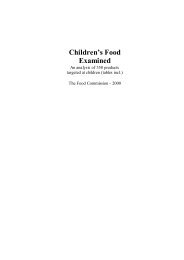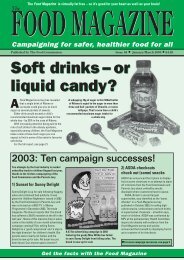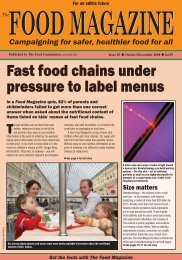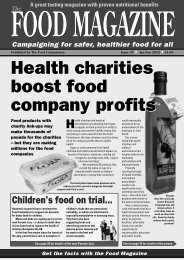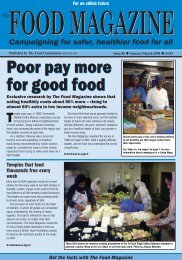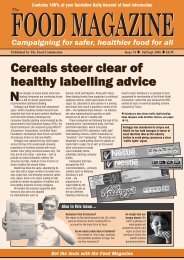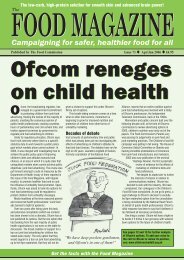Children's Nutrition Action Plan - The Food Commission
Children's Nutrition Action Plan - The Food Commission
Children's Nutrition Action Plan - The Food Commission
You also want an ePaper? Increase the reach of your titles
YUMPU automatically turns print PDFs into web optimized ePapers that Google loves.
Key findings included that:<br />
• 73% of children ask parents to buy sweets and crisps that they had seen advertised;<br />
• 71% had bought something on the strength of a free gift or a special offer;<br />
In an examination of TV commercials shown during children’s viewing times, Blackmail<br />
found that between 21% and 58% of all commercials were for food products. A nutritional<br />
analysis of the advertised foods found that<br />
• Between 88% and 99% of those foods were high in fat and/or sugar and/or salt;<br />
• 53% of the foods were cakes, biscuits and confectionery.<br />
Government advice states that fatty and sugary foods should form a maximum 7% of the diet.<br />
<strong>The</strong> report states that there is strong evidence that the cumulative effect of this advertising<br />
helps to ‘undermine progress towards national dietary improvement… by setting bad<br />
examples, particularly to children’.<br />
Co-op Codes of Practice<br />
In response to this research, the Co-op has taken steps to address its own contribution to the<br />
marketing of foods to children. As first steps, it has stopped its own advertising of fatty,<br />
sugary and salty foods during children’s TV viewing times, and is actively campaigning for<br />
the ITC to impose restrictions on such advertising. It is also calling for people and<br />
organisations throughout the food chain to follow its lead.<br />
<strong>The</strong> Co-op code of practice on advertising to children<br />
• <strong>The</strong> Co-op will not advertise sugary/fatty and salty foods and drinks:<br />
- During key children’s viewing hours on TV;<br />
- In specific children’s titles;<br />
- Adjacent to children’s pages in newspapers.<br />
• Advertisements aimed specifically at children will not contain any sugary/fatty/salty<br />
foods.<br />
• In advertisements aimed at adults for children (e.g. Back to School), one third will be ‘eat<br />
more’ lines as classified by the Balance of Good Health.<br />
• Co-op Brand in-store demos will not demonstrate sugary/fatty/salty products aimed<br />
specifically at children.<br />
• Co-op in-store theatre will not use high-profile character merchandising, including TV<br />
Creatures, to promote sugary/fatty/salty products/categories aimed at children.<br />
• <strong>The</strong> Co-op will not encourage purchase of sugary/fatty/salty foods through free gifts.<br />
• <strong>The</strong> Co-op will not use any cartoon characters, including TV Creatures on the packaging<br />
of sugary/fatty/salty foods.<br />
<strong>The</strong> Co-op’s Children’s Products Policy<br />
• Appropriate nutritional balance compared with similar products particularly relative level<br />
of fat, saturates, sugar and salt.<br />
• No pharmacologically active substance, e.g. caffeine, alcohol.<br />
• Particular attention to additives and allergens.<br />
• Addition of minerals and vitamins should be:<br />
- Consistent with similar regular products;<br />
<strong>The</strong> Children’s <strong>Nutrition</strong> <strong>Action</strong> <strong>Plan</strong>, published by <strong>The</strong> <strong>Food</strong> <strong>Commission</strong><br />
33



